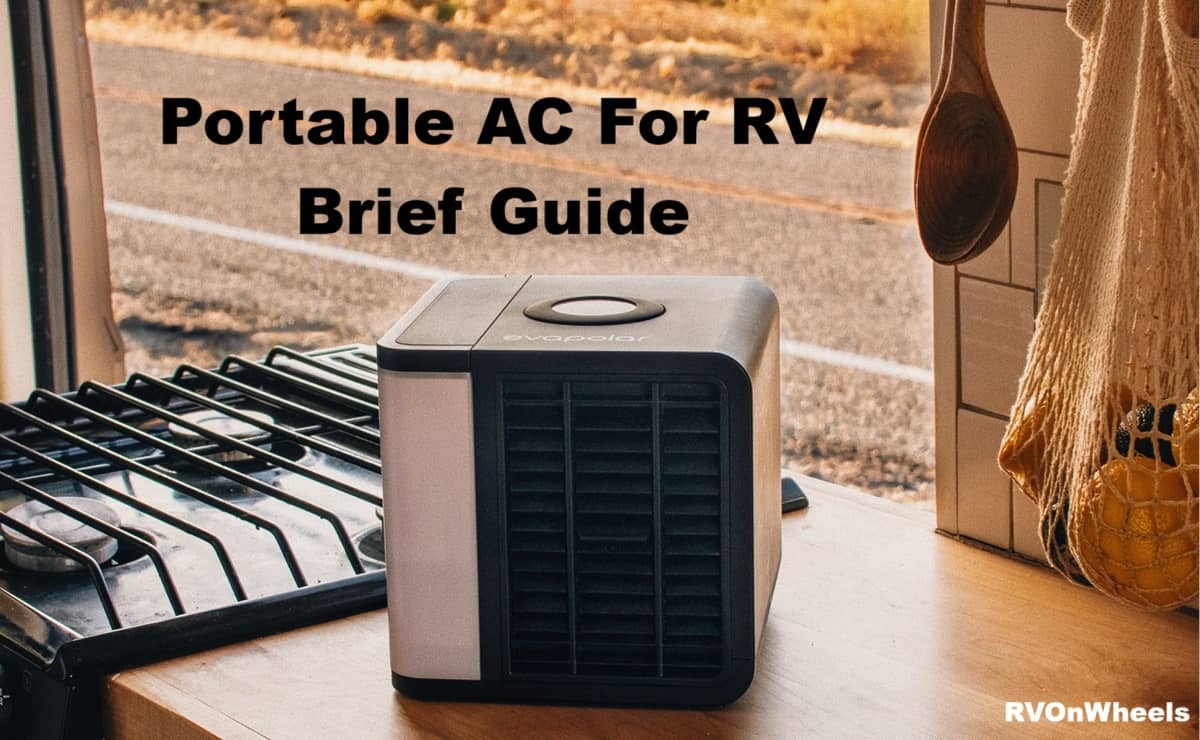Are you low on budget but still want to enjoy an incredible experience inside the RV? A Portable AC for RV is the best solution for you. Don’t worry, we’ve got you covered, here’s a detailed guide for you.
Portable AC units are cheaper and quicker solutions for RVers. They are easy to install and take up tiny space inside the RV. Here, we will share detailed information about Portable ACs and their maintenance tips. Moreover, we will share the 7 best portable air conditioners to make your purchase easy.
This brief blog post will teach you everything you need to know about Portable ACs. After reading it, you will know how and where to buy them. Let’s quickly get into the details of this guide to help you find the best Portable AC for you!
Types Of Portable AC for RV
There are many portable ACs in the market to choose from depending on budget, capability, and the size of your RV. Two main types of portable ACs work for all types of RVs:
Vented Portable AC Units
Vented Air conditioners are widely used and more effective than the non-vented ones. These ACs need to be placed near the window to access the air. Vented portable ACs use the outside air to cool the temperature. Vented units use fresh outdoor air to filter out the stale air from the RV interior while also using evaporated water to prevent the room from drying out.
However, if you don’t have access to windows inside the RV, it would help if you drilled small holes in your RV’s walls that allow the stale air to pass through vents for efficient distribution.
Vent-Free Portable AC Units
The second option is Vent-free AC units. These units also use evaporated water but cannot cycle out stale air. Unlike the other portable ACs for RVs, these don’t require any external vents as they use a refrigerant cycle to cool.
However, they are ineffective for humid climates because they are unable to remove moisture from the air. After cooling down the interior of the RV, the moisture in the air doesn’t get removed, resulting in a humid and uncomfortable atmosphere inside. But, if you are traveling through a dryer climate, vent-free units will work fine.
How Does Portable AC Work?
Portable AC for RVs use a refrigerant, compressor, and fan to cool the RV. Their primary purpose is to pull the warm air from the inside and transfer it to the outside of the RV. The key components involved in this process are:
- Evaporator coil and the refrigerant: The Evaporator coil and the refrigerant are responsible for cooling the air.
- Condenser coil: It is used to cool down the hot refrigerant.
- Compressor: It raises the refrigerant temperature for the condensation process.
- Fan: It allows the air to move around as needed.
The refrigerant plays a crucial role in the whole process. It cools the room air and is used as a heat exchange medium. The refrigerant then absorbs the heat from the air inside the RV. When the refrigerant is compressed, heat is generated, which needs to be exhausted. That is why portable units have an exhaust hose, allowing the heat to vent outside the room.
Things To Consider Before Buying Portable AC For RV
Choosing a portable AC might be confusing, as many models are in the market. However, some factors will help you make a choice. Let’s discuss these factors.
BTU Levels
BTU, or British Thermal Unit, is an energy metric that refers to the heat an AC can remove from a space in a specific time. Knowing the BTU levels is essential before purchasing a portable AC unit.
To find out the required BTU levels for your RV:
- Measure the length and width of the room where the AC needs to be installed.
- Measure in feet and inches.
- Convert the obtained measurement into square footage by multiplying the length by the width.
Here’s how you can calculate the BTU
1 square foot is equivalent to 20 BTUs, so simply multiply the square foot of your space by 20 to receive a BTU estimate.
For example, 250 square feet x 20 BTU = 5,000 BTU
Brand
Consider buying Camper AC from a reputable brand to avoid potential issues. Look for brands that offer reliability, good customer service, and extended warranty. Good brands may cost more, but they are worth it for longevity.
Pricing
Portable ACs for RVs are affordable compared to the other units. Typically, a rooftop air conditioner costs from $700 to $2500; on the other hand, most portable ACs cost around $500. It’s a benefit for RVers who don’t have much funds yet want to experience a relaxed atmosphere in their RVs.
Features
Portable RV ACs have extra features, like a remote control, a timer, etc. For Rvers who are on a budget, we recommend these ACs. This will help keep you on a budget so you can save and enjoy a fun summer adventure!

The 7 Best Portable Air Conditioners For Your RV
Many high-tech portable ACs for RVs are available with intelligent features that provide optimized cooling and performance. Portable ACs are often cheaper when compared to the standard units, ranging from $300 to $700. Here are the 7 best portable Air conditioners you can buy.
Whynter Elite ARC-122DS
Whynter portable AC is one of the best Portable AC units on the market. It measures 17 inches wide and 29.5 inches tall with a depth of 16 inches, making it small enough to fit into most RV closets.
LG LP0621WSR
This unit is also built for smaller spaces. It comes with a 250-square-foot cooling capacity. It can generate 6000 BTUs of cooling. The measurements for LG LP0621WSR are 17.32 inches wide and 27.36 inches tall, with a depth of 13.27 inches.
Whynter ARC-14S
Whynter ARC-14S provides enhanced cooling and can achieve up to 9,500 BTU of cooling power. This unit is taller than others; it measures 35.5 inches tall and costs up to $499 from Amazon.
Homelabs Portable Air Conditioner
Homelabs Portable AC for RV is a powerful unit that offers 10,000 BTUs of cooling for spaces up to 600 square feet. You can buy it from Amazon for $510.
De’Longhi Pinguino PAC EX390LVYN
This unit offers cooling for larger spaces up to 700 square feet. It has some extra features, including monitoring the temperature around the unit’s remote via Bluetooth. It also offers an extra-quiet operating mode designed to reduce the noise from the fan. You can buy De’Longhi Pinguino PAC EX390LVYN for $700 from Amazon.
Frigidaire FHPC082AC1
Frigidaire FHPC082AC1 offers moderate cooling with 5500 BTUs and covers up to 350 square feet of space. It is best for smaller spaces, with decent performance and a value price. You can buy it from Amazon for $300.
Midea MAP08R1CWT
Midea MAP08R1CWT is another affordable solution for Rvers with smaller trailers. With 5,300 BTU, this machine provides moderate cooling for small spaces. You can buy it from Amazon for $300.
Maintenance Tips For Portable AC
Continuous maintenance of your RV AC is essential to improve its performance and efficiency. It will also save you from extra repairs and increase the life of your AC unit. Below is a list of some practical maintenance tips;
- Keep AC Clean
There’s not much labor required to clean the AC, but it’s essential to keep your AC functioning as it should be. A dirty air unit can minimize the cooling and cause the unit to blow only lukewarm air. Clean the AC using a soft-bristled brush and warm water.
- Check AC Filter
A dirty AC filter sends dust everywhere each time it’s used, damaging the portable AC unit. It can also cause foul odors that might be unpleasant to users. A dirty air filter must be cleaned at regular intervals or changed every 3 months.
- Use AC In Appropriate Space
Remember to take interior measurements before buying a portable AC for your RV. Make sure to buy the AC according to the unit’s space. For that, you need to consider BTUs. If the room is too big, using an AC with fewer BTU ratings can reduce the unit’s efficiency and lifespan.
Read Also: Why Is My RV AC Leaking Water Inside?
Final Words
This was all about Portable AC for RV. Although these ACs may not be as efficient as the standard ACs, they are a cost-effective solution for Rvers who need flexible cooling options while on the road. With some adjustment, a portable AC can easily fit in your RV without taking up much space.
After going through this guide, you have enough knowledge about portable AC units to make an informed decision before purchasing. We recommend the Homelabs Portable Air Conditioner due to its affordability and cooling capability. If you are also using any of these Acs, remember to share your experience with us in the comment section.
FAQs
How to Vent Portable AC in RV?
To vent a portable AC in an RV, you need to attach the window kit to a window and connect the exhaust hose. Use a sealant to Seal gaps around the window kit. If there is no window in your RV, drill a small hole in the RV wall and use a wall adapter.
Can I Use a Portable Air Conditioner in a Van?
Yes, you can use a portable AC in an RV. It will help cool the atmosphere inside the Van. Portable RV AC units range in affordability, size, BTU ratings, and more, so it’s better to research and find the best Travel Trailer AC per your requirements.
How Many BTUs Do I need For a Portable AC in an RV?
The number of BTUs required to run a portable AC depends on the size of your RV. For smaller vans (up to 200 square feet), a portable AC with 5,000 to 6,000 BTUs is enough. Larger RVs require a unit with 12,000 BTUs or more to cool the space effectively.

